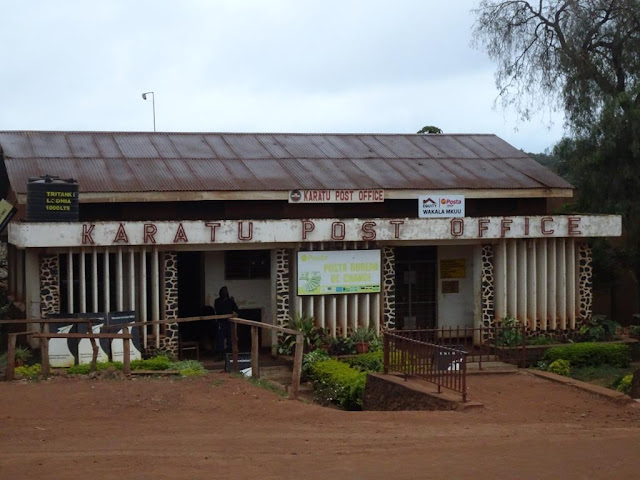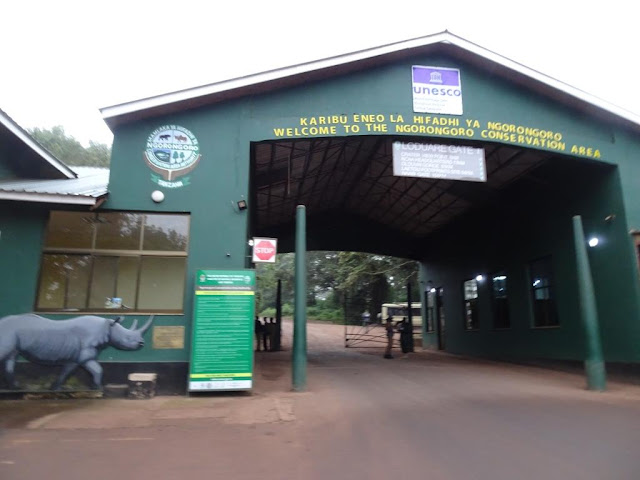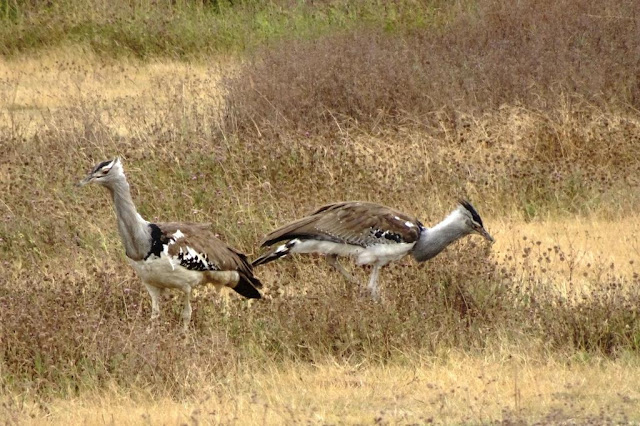
In several areas the fog was quite dense and we couldn't see very far. The picture below is when it was clearing!

Arriving at the conservation area we stopped to look at some of the displays while we got our paperwork to enter.
 Established in 1959, Ngorongoro covers over 3125 square miles. It was designated a UNESCO world heritage site in 1979. We climbed from an elevation around 5000' to over 8100' to reach the caldera. As we made our descent, the mist began to clear. We could see hundreds of wildebeest in the caldera, as well as zebras.
Established in 1959, Ngorongoro covers over 3125 square miles. It was designated a UNESCO world heritage site in 1979. We climbed from an elevation around 5000' to over 8100' to reach the caldera. As we made our descent, the mist began to clear. We could see hundreds of wildebeest in the caldera, as well as zebras. 


Several of the zebras enjoyed rolling in the dust! Much of the wildlife share the same areas - the zebras, warthogs, and crown crested cranes ignored each other.


Arriving at the conservation area we stopped to look at some of the displays while we got our paperwork to enter.
 Established in 1959, Ngorongoro covers over 3125 square miles. It was designated a UNESCO world heritage site in 1979. We climbed from an elevation around 5000' to over 8100' to reach the caldera. As we made our descent, the mist began to clear. We could see hundreds of wildebeest in the caldera, as well as zebras.
Established in 1959, Ngorongoro covers over 3125 square miles. It was designated a UNESCO world heritage site in 1979. We climbed from an elevation around 5000' to over 8100' to reach the caldera. As we made our descent, the mist began to clear. We could see hundreds of wildebeest in the caldera, as well as zebras. 


Several of the zebras enjoyed rolling in the dust! Much of the wildlife share the same areas - the zebras, warthogs, and crown crested cranes ignored each other.

If you look closely you can see the black rhino in the field. We're not sure how she did it, but Ann spotted it and it was FAR in the distance! YEAH!!! There are about 48 rhinos in the park. They are endangered partly because they are solidary animals and have few chances to mate. Poachers and changes in the habitat also add to their dilemna.

We also sighted a hyena in the grass - then it got up and walked a while. Check out those teeth!

 There were a couple lions sleeping in the grass. They were resting because they had killed a wildebeest and feasted on it before we got there.
There were a couple lions sleeping in the grass. They were resting because they had killed a wildebeest and feasted on it before we got there.


We also sighted a hyena in the grass - then it got up and walked a while. Check out those teeth!

 There were a couple lions sleeping in the grass. They were resting because they had killed a wildebeest and feasted on it before we got there.
There were a couple lions sleeping in the grass. They were resting because they had killed a wildebeest and feasted on it before we got there. 
One hippo would get up and move, then then next, changing positions!

 That's a face that only a mother could love!
That's a face that only a mother could love!

Covered in birds!


 That's a face that only a mother could love!
That's a face that only a mother could love!
Covered in birds!

Our lunch stop. As you can see, there are lots of tour groups doing game drives!

We spotted giraffes in the afternoon and an elan.


I don't remember this bird, but even though it looks like a hawk, I think it was one of the vultures.
The bird below is a blacksmith plover. It makes a metallic like sound - especially when it is protecting its nest.
 There were fields of crown crested cranes.
There were fields of crown crested cranes.


We spotted giraffes in the afternoon and an elan.


I don't remember this bird, but even though it looks like a hawk, I think it was one of the vultures.

The bird below is a blacksmith plover. It makes a metallic like sound - especially when it is protecting its nest.
 There were fields of crown crested cranes.
There were fields of crown crested cranes.
We made out way out of the caldera and headed to Kisura Kenzan Tented Camp in Serengeti National Park. Again, as we gained elevation the area became more forested.















No comments:
Post a Comment